Quickly moving away from impressionism with which he cut his teeth, Paul Gauguin developed, during his stays in Brittany and then in the islands, a powerful, synthetic pictorial language, both symbolic and decorative. His particular use of color opens the way to modernity.
In 1871, Gauguin, freed by the Navy, put his gear in Paris, where his tutor, Gustave Arosa, opened the doors to him a career in the middle of stockbrokers. Above all, it opens his eyes to the contemporary paintings he collects. Soon, Gauguin seizes the brushes, initiating himself as an autodidact in this demanding art in a realistic vein. In 1876, for the one and only time, one of his paintings was exhibited at the Salon. He then began to gravitate around the Impressionist sphere and also began to collect these avant-garde painters.
In the summer of 1879, he worked in Pontoise with Camille Pissarro, whose teaching is reflected in his paintings. Constructing the form by dividing the brushstroke according to the law of simultaneous color contrasts, this lesson of Impressionism permeates his production: his landscapes of course, but also his still life and his figures.
However, in a work like the Sleeping Child, an ambiguity arises as to the reality of its object: in the upper part, the motifs of the wallpaper seem to arise from the dreamlike activity of the dozing little boy. Paul Gauguin follows in the footsteps of Cézanne, whose backgrounds he rented for his paintings were “as imaginative as they are real”. It also announces the Tahitian daydreams to come.
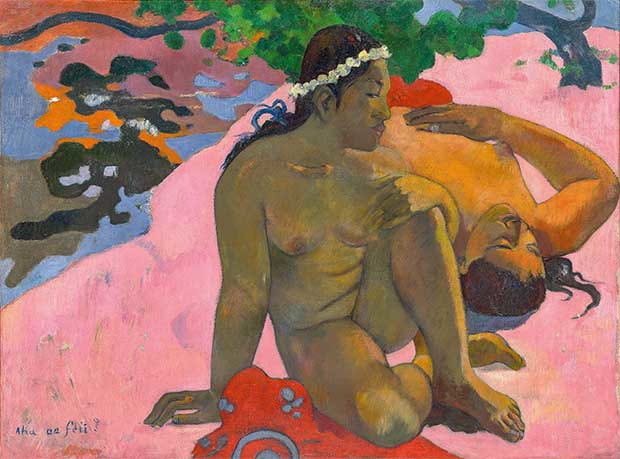
The Impasses of Impressionism
While he abandoned his work in 1883 to devote himself to painting, Paul Gauguin participated in Impressionist exhibitions until the last edition in 1886, dominated by the pointillism of Seurat. But, in the mid-1880s, he broke away from this movement, rejecting its narrow realism, enslaved by physical sensations. The Impressionists “study color exclusively as a decorative effect, but without freedom, retaining the shackles of resemblance,” he notes. They searched around the eye and not in the mysterious center of thought, and from there fell into scientific grounds.
Also Read: Interchange by William de Kooning Critical Analysis
His criticism targets, among other things, the optical theories to which his friends conform: Beware of complementary colors which give clash and not harmony”, he affirmed, according to the testimony of Daniel de Monfreid. These reflections will cause his conception of color to evolve, as we will see, in original directions.
Pont-Aven and The Revelation of Primitivism
In July 1886,Paul Gauguin landed in Brittany in the small Finistère village of Pont-Aven, frequented by painters for several decades. He hopes to live there cheaply, but not only. ” I love Brittany, I find the savage, the primitive there, “he wrote. When my hooves echo on this granite ground, I hear the dull, dull, and powerful tone that I seek in painting. Long before his discovery of Tahiti, the artist’s primitivism found a chosen terrain on the banks of the Aven, far from any folklorism or any nostalgia.
“From the outset, Gauguin’s cultural primitivism was concerned neither with a lost state of nature nor with its possible counterpart in the future” explains art historian Kirk Varnedoe. But he was drawn to places where a deep past seemed to survive in the present.
The mystery that fascinated him he found in non-urbanized but contemporary societies whose existence, although free from modern artificiality, was nevertheless dependent on the maintenance of the traditions of a very ancient society.
In many ways, nineteenth-century Lower Brittany fits this description. If Breton motifs begin to populate his paintings, the crystallization of a new aesthetic will only take place during his second stay, in 1888. In the meantime, Gauguin attempted a first tropical adventure, in Panama then in Martinique, which inspires some landscapes still dependent on the impressionist way.
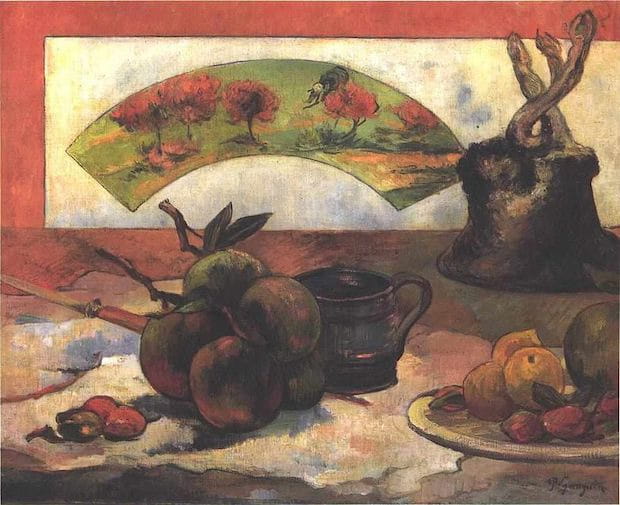
The Audacity of Synthetics
The Vision after the sermon, painted during the summer of 1888, on the other hand, marks a radical break. A veritable anti-naturalist manifesto, this painting depicts Breton women in traditional costume who, coming out of mass, see in a dream Jacob’s struggle with the Angel; this takes place in the upper right corner of the painting, on a vermilion-red plain, barred by a tree trunk.
Uniting the visible and the visionary in a stylized drawing, the artist frees himself from all verisimilitude both in perspective and in color. He draws from various sources, to say the least, borrowing his framing from Degas, the simplification of forms from popular imagery, and the flat areas of color from Japanese prints. He also appropriates the achievements of cloisonnism developed by Émile Bernard. ” I believe I have achieved in the figures a great rustic and superstitious simplicity – all very severe”, he wrote, satisfied, to Van Gogh. Before joining the Dutch painter, at the end of October, he transmitted the fruit of his experiences to his disciple Paul Sérusier.
In the Bois d’Amour, in Pont-Aven, the latter painted a small landscape under the dictation of the master. He remembers: “How do you see these trees? Yellows, well put on yellow, the most beautiful yellow in your palette suggests Paul Gauguin. This shadow? Rather blue, paint it with pure ultramarine, and those leaves? Reds, put some vermilion. This Talisman, as it will soon be baptized, recalls that “a painting – before being a battle horse, a naked woman or any anecdote – is essentially a flat surface covered with colors in a certain order assembled, according to the formula famous by Maurice Denis.
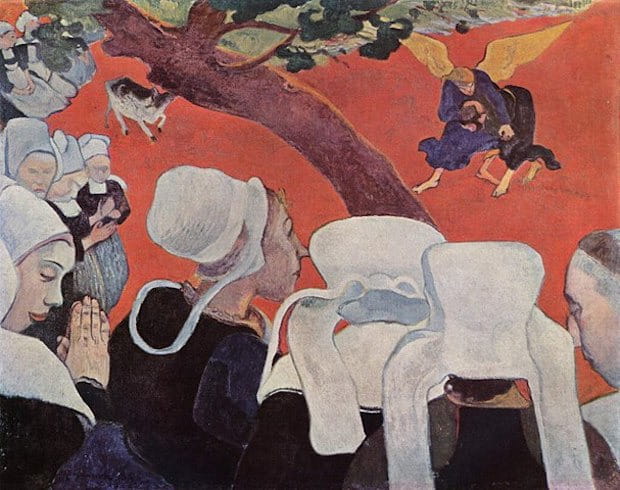
Van Gogh and The Experiences of The South
On October 23, 1888, Gauguin found Van Gogh in Arles, in this “studio of the South” so desired by the Dutch painter. Stormy, the legendary meeting between the two men nevertheless proves fruitful on the artistic level.
In the south of France, Gauguin deepens the research undertaken in Brittany towards an ever more synthetic and decorative painting, as shown for example Laveuses in Arles, where the colored masses collide in a space without depth. Through works such as Les Alyscamps, he specifies a more hieratic vision, quite far from the undulating line of Van Gogh.
After the dramatic episode of the cut ear on December 23, Paul Gauguin prefers to leave Arles, but he takes with him an invaluable sum of experiences which will notably influence his artistic and personal destiny.
Through the expressionist incandescence of its coloring, Le Christ Jaune, which he painted at Pont-Aven during the summer of 1889, seems to recall Van Gogh. The writer Octave Mirbeau sees in it, for his part, “a disturbing and tasty mixture of barbaric splendor, Catholic liturgy, Hindu reverie, Gothic imagery, obscure and subtle symbolism”. This syncretic character, which also surfaces in La Belle Angèle, will find its fulfillment during the Tahitian period.
Critical Recognition: Paul Gauguin, the Symbolist
If Gauguin is already thinking of a departure for the Tropics, he is no less concerned about the reception of his works. He thus counted a lot on his participation in the exhibition of paintings by the impressionist and synthetist group, at the Café des Arts, during the Universal Exhibition in Paris in 1889. But this event, which saw the first appearance of the term “synthetist”, does not yield the expected results.
On the other hand, a section of the critics perceived Gauguin’s originality well and hailed his major role among the young symbolist generation. In 1891, the critic Albert Aurier published a famous article in the Mercure de France, “Le Symbolisme en Peinture. Paul Gauguin”, intended to set a date and guide the reading of the artist’s work.
Seeing in his paintings ” of Plato plastically reinterpreted by a savage of genius “, he develops an idealistic thesis which tends to make the work the expression of a metaphysical idea that pre-exists in any artistic work. In fact, the critic completely neglects the materiality of the painting, the latter resulting from a permanent interaction between the intention of the painter and the suggestions and resistances of the material. Gauguin himself said he was sensitive to the “character of the material”, thus recognizing its active role in the genesis of the works. Although he was pleased with Aurier’s support, the painter would, ten years later, tax these ideas with “critical-literary lucubrations”.
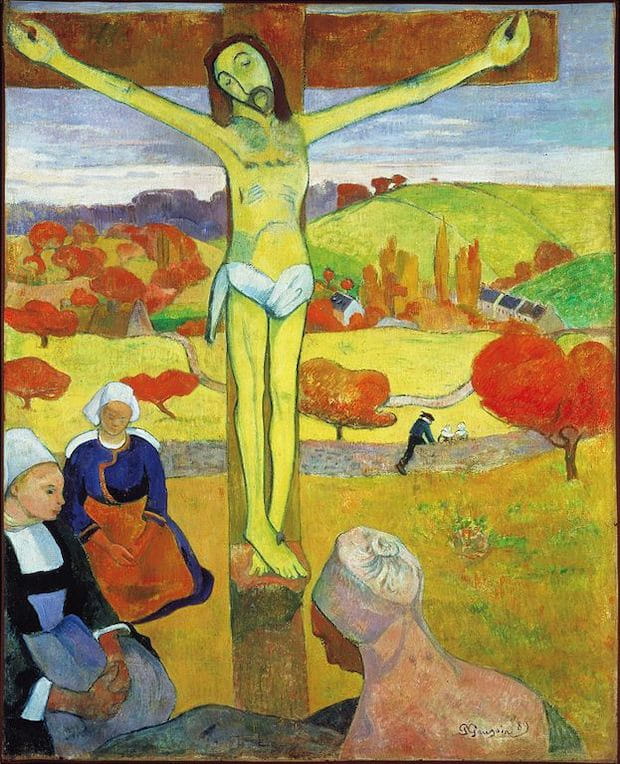
A New World to Paint
In 1891, Paul Gauguin left for Tahiti where he arrived on June 9. There, he can only observe the disappearance of Polynesian civilization and religion under the dissolving influence of colonialism. More than a disappointment, he sees in it an invitation to paint “from the imagination”, as he advised Van Gogh. Admittedly, the artist is captivated by the powerful and indolent bodies of Polynesian women, “animal figures of statuary rigidity”, in which he perceives “something ancient, august, religious in the rhythm of their gesture, in their rare immobility” and “in their dreaming eyes, the troubled surface of an unfathomable enigma”.
But if he accumulates drawings – “documents”, as he calls them – Gauguin also draws from a stock of photographic images representing Greek, Egyptian or Javanese works the elements of his compositions. These constitute as many supports for his research on colors, following the example of Manaò Tupapaú whom he describes in these terms in a letter to his wife: “Dark, sad, frightening general harmony ringing in the eye like a funeral knell. Violet, dark blue, and orange-yellow. I do the greenish linen […] this yellow linking the orange-yellow and the blue completes the musical chord.
Against the “clashes” of complementary elements for which the Impressionists are reproached, he favors the juxtaposition of “derived”, that is to say secondary, colors (violet, orange, green), from which he draws suggestive harmonies. On June 4, 1893, the painter, at the end of his resources, left Tahiti. As soon as he returned to Paris, an exhibition of his recent paintings was organized at Ambroise Vollard. But in Gauguin’s mind, this stay in France was only a parenthesis.
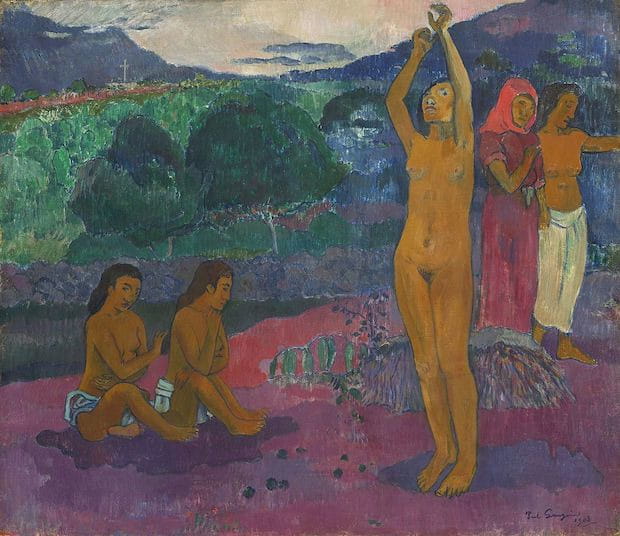
The Music of Colors
Two years later, he embarked again on Polynesia and never came back. Before this final departure, the artist had answered questions from L’Écho de Paris, thanks to which he had been able to clarify his conceptions of color. “So, your red dogs, your pink skies? asks the journalist. ” They are necessary and everything in my work is calculated, meditated on at length. It’s music if you will! I obtain by arrangements of lines and colors, with the pretext of any subject borrowed from life or nature, symphonies, harmonies representing nothing absolutely real in the vulgar sense of the word, expressing nothing directly no idea, and which should make you think as music makes you think, without the aid of ideas or images, simply by mysterious affinities which exist between our brains and such arrangements of colors and lines. Coming from Romanticism, the idea of an analogy between painting and music irrigated the Symbolist era before finding its fulfillment in abstract art.
Latest Masterpieces
During his second stay in Tahiti, a work summarized Paul Gauguin’s pictorial conceptions, at the same time as it embodied “a philosophical sum of life, civilization, and sexuality” (Richard Bretell): Where do we come from? We? What are we? Where are we going?
This monumental composition, four meters long, was exhibited in 1898 at Vollard’s, surrounded by nine other canvases that the critic Thadée Natanson considered both “replica fragments and studies”. It is certain, on the other hand, that these paintings were designed to be shown at the same time, forming a total decorative ensemble.
In 1901, Gauguin finally realized the wish formulated six years earlier and went into exile in the Marquesas Islands, on the island of Hiva Oa. Less productive on the pictorial level, this last period of his life is the theater of an intense work of writing, thanks to which he engages both in a reflexive return on his career and in a theological-moral synthesis, under the title ambitious of The Modern Spirit and Catholicism.
Defeated by chronic health problems, the painter died in 1903. From then on, his aura continued to grow among the younger generations, Fauves and Expressionists. ” Among all others, painting is the art that will pave the way by resolving the antinomy between the sensible world and the intellectual, wrote the artist in a treatise on color. Was this movement of a painting by color foreseen, implemented by someone? I cannot conclude and then designate it. It’s up to posterity. This one gave him the name of Gauguin.
